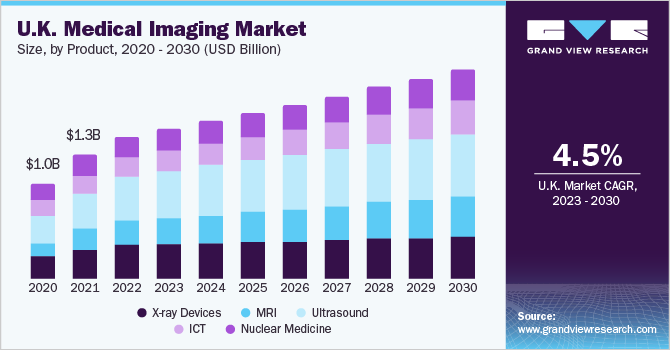Medical Imaging Industry Overview
The global medical imaging market size was valued at USD 28.02 billion in 2021 and is expected to expand at a compound annual growth rate (CAGR) of 4.9% from 2022 to 2030. The increasing prevalence of lifestyle-related diseases, rising demand for early detection tools, technological advancements to improve turnaround time, increased investment & reimbursement initiatives undertaken by the government, and expansions of new facilities by market players in developing nations, are said to boost the market growth. For instance, in June 2021 the government of India launched X-Ray Setu, a free Artificial Intelligence (AI)-based platform to aid doctors with the early COVID-19 interventions. In 2022, Siemens Healthineers introduced a new CT scanner production unit in India, to fulfill the growing demand for CT scanners and boost its market position.

Moreover, in August 2020, Philips expanded its cardiovascular ultrasound portfolio by launching Affiniti CVx. The system is designed to help cardiology departments and provide better care to more patients while improving efficiency and throughput. Furthermore, in November 2021, Philips announced the launch of an AI-enabled MR imaging portfolio, which is intended to improve the efficiency and sustainability of radiology operations by speeding up MR exams. Such technological advancements are said to boost the market growth exponentially.
Gather more insights about the market drivers, restraints, and growth of the Global Medical Imaging Market
Increasing demand for state-of-the-art imaging modalities by teaching hospitals and universities to provide training for advanced technology is expected to have a significant impact on the market growth during the forecast years. Furthermore, the adoption of AI to automate image quantification and identification process is also expected to boost the market growth. For instance, Google’s AI platform, named, Google’s Deepmind collaborated with Moorfields Eye Hospital to read all eye scans performed using an optical CT scanner, to ensure early detection of age-related macular degeneration. In addition, the introduction of 3D MRI and CT scans enables radiologists to quickly analyze scans, reducing analysis time and improving efficacy.
Moreover, computer vision is being used to diagnose conditions, that are not visible to the human eye. Despite the technical improvements and increased adoption of advanced imaging tools, the market witnessed a decline due to the outbreak of the COVID-19 pandemic. Reduction of imaging volumes, economic setbacks leading to reduced adoption of advanced imaging equipment, reduced staff at radiology centers & hospitals, and increased adoption of teleradiology services, are factors impacting the drop in the market.
Browse through Grand View Research's Medical Imaging Industry Related Reports
Hand-held X-rays Market - The global hand-held x-rays market size was valued at USD 726.5 million in 2022 and is projected to impel at a compound annual growth rate (CAGR) of 10.9% from 2023 to 2030.
Computed Tomography Market - The global computed tomography market size was valued at USD 4,045.6 million in 2021 and is projected to expand at a compound annual growth rate (CAGR) of 7.3% from 2022 to 2030.
Medical Imaging Industry Segmentation
Grand View Research has segmented the global medical imaging market based on product, end-use, and region:
Medical Imaging Product Outlook (Revenue, USD Million, 2018 - 2030)
- X-ray
- Ultrasound
- Computed Tomography
- Magnetic Resonance Imaging (MRI)
- Nuclear Imaging
Medical Imaging End-use Outlook (Revenue, USD Million, 2018 - 2030)
- Hospitals
- Diagnostic Imaging Centers
- Others
Medical Imaging Regional Outlook (Revenue, USD Million, 2018 - 2030)
- North America
- Europe
- Asia Pacific
- Latin America
- MEA (Middle East & Africa)
Market Share Insights:
March 2020: GE Healthcare increased its manufacturing capacity by opening new production facilities, to meet the growing demand for advanced imaging tools, especially during the COVID-19 pandemic.
October 2019: Canon received the U.S. FDA nod for its Advanced Intelligent Clear-IQ Engine (AiCE), an AI technology for integration with its Aquilion Precision scanner. The technology helps in achieving precision diagnostic without the need to increase the dose.
Key Companies profiled:
Some prominent players in the global Medical Imaging Industry include
- GE Healthcare
- Koninklijke Philips N.V.
- Siemens Healthineers
- Canon Medical Systems Corp.
- Mindray Medical International
- Esaote
- Hologic, Inc.
- Samsung Medison Co., Ltd.
- Koning Corp.
- PerkinElmer Inc.
- FUJIFILM VisualSonics Inc.
- Cubresa Inc.
Order a free sample PDF of the Medical Imaging Market Intelligence Study, published by Grand View Research.


No comments:
Post a Comment